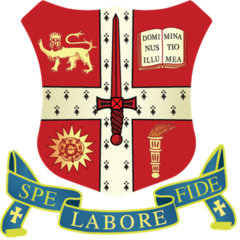Central Foundation Boys' School
 |
|
| Motto |
Latin: Spe Labore Fide (By work, by hope, by faith) |
|---|---|
| Established | 1865 |
| Type | Voluntary aided school |
| Headteacher | Jamie Brownhill |
| Location |
Cowper Street Islington London EC2A 4SH United Kingdom |
| Local authority | Islington |
| DfE number | 206/4614 |
| DfE URN | 100458 Tables |
| Ofsted | Reports |
| Staff | 110 |
| Students | 900 |
| Gender | Boys (mixed Sixth Form) |
| Ages | 11–18 |
| Houses | 4; Rogers , Gassiot , Wormell and Alleyn |
| Colours | Blue and Gold |
| Website | Central Foundation Boys' School |
Central Foundation Boys' School is a voluntary-aided comprehensive secondary school in the London Borough of Islington. It was founded at a meeting 1865 and opened the following year in Bath Street, before moving to its current location on Cowper Street in 1869. Originally named The Middle Class School of London, it was renamed in 1890 after the establishment of its trust body, the Central Foundation Schools Trust. Its sister school is Central Foundation Girls' School in Tower Hamlets. Both schools are beneficiaries of the charity Central Foundation Schools of London, which in turn is a beneficiary of The Dulwich Estate, successor to the historic Alleyn's College charity.
There are 750 pupils in the school aged 11–16, all of whom are boys, and around 200 sixth form students aged 16–19, both boys and girls. The sixth form is part of the Islington Sixth Form Consortium, a shared sixth form project with three other schools in Islington which is why the intake is mixed sex. The current Headteacher is Jamie Brownhill who has occupied the post since 2010.
Pupils generally take ten General Certificate of Secondary Education (GCSE) tests in Year Eleven (aged 15–16) and they have a choice of three or four A-levels or a vocational BTEC in the sixth form (16–19). An Office for Standards in Education, Children's Services and Skills (Ofsted) inspection in 2015 graded Central Foundation Boys' School as "outstanding", the highest ranking a school can have. The majority of students go on to higher education following the completion of their A-levels at the end of Year Thirteen (aged 17–18) with a third of pupils going to the top third most selective universities in the country.
Revered William Rogers, a social reformer who had already established eight schools, became convinced that London was full of academies for gentlemen and much had been done for the poor but there was little on offer for parents who could afford about £1 a quarter for their education. In February 1865 he called a meeting of his wealthy friends at the Mansion House and raised £41,000 for the establishment of a middle class school. The school was opened on Bath Street on 1 October 1866 by Sergeant Edgar at 9:30am. Having started with 300 pupils, by the end of the first year over 700 attended the school. Like his other schools, the building had a previous occupier and was converted into a school but for this venture he wanted a building erected for the purposes of being a school which led him and the Corporation for Middle Class Education for the City of London to purchase a two-acre plot in nearby Cowper Street for £30,000 (equivalent to £30m today) where the school moved to in 1869 and remains to this day. By the time The Great Hall of the main building was erected in 1873, there were over 900 boys in attendance with it reaching 1,000 at its peak.
...
Wikipedia
